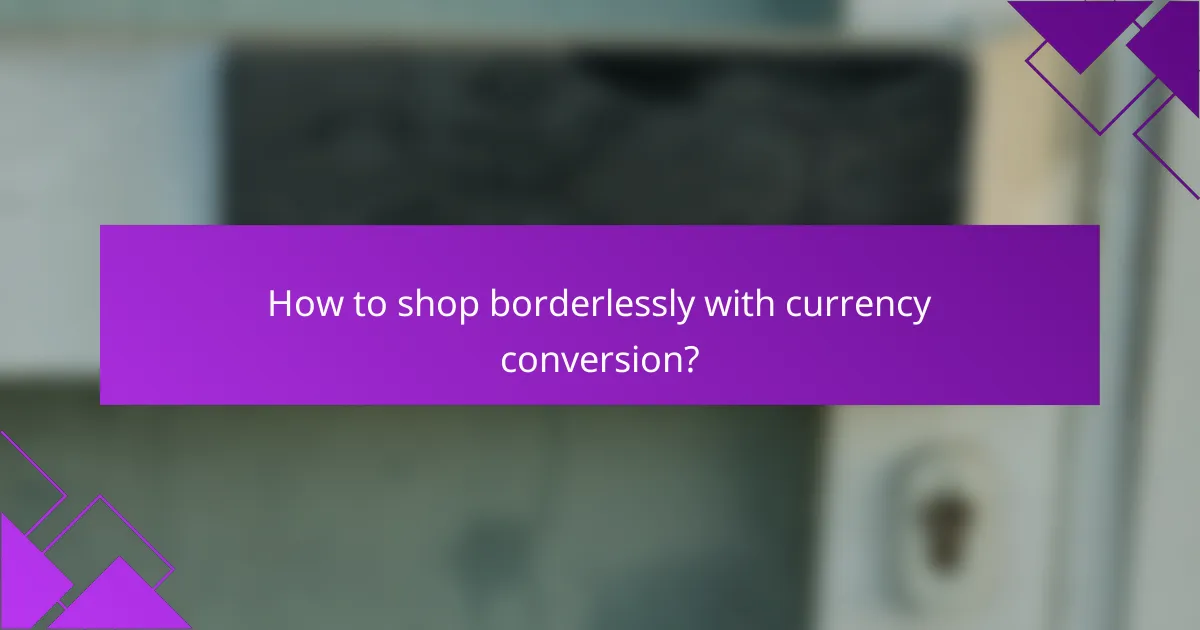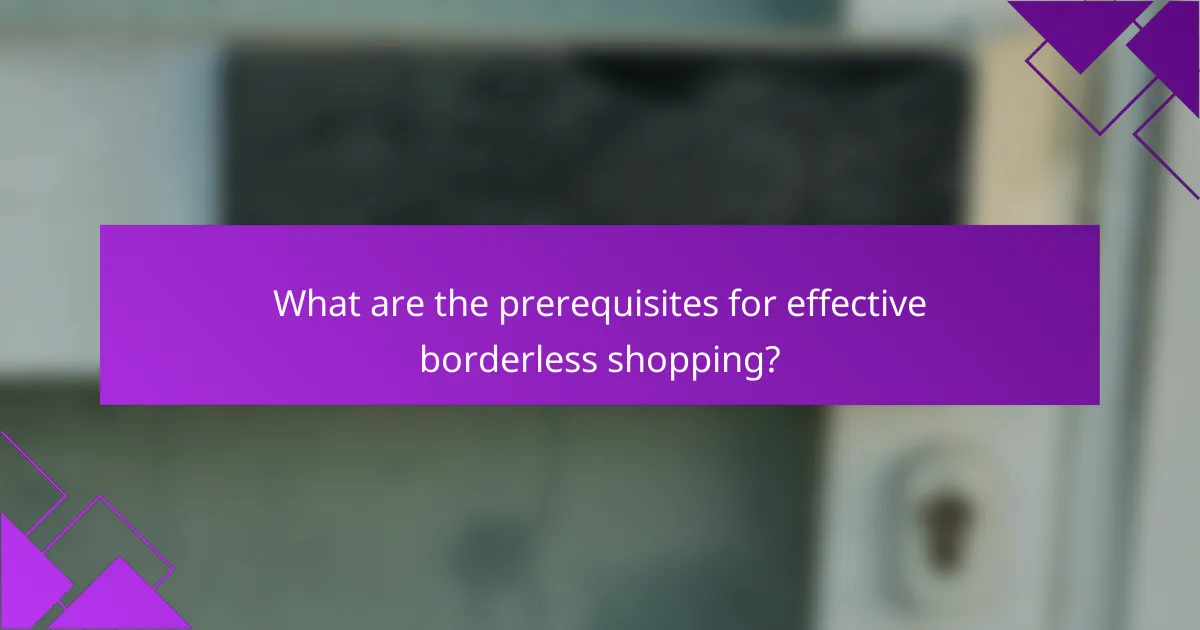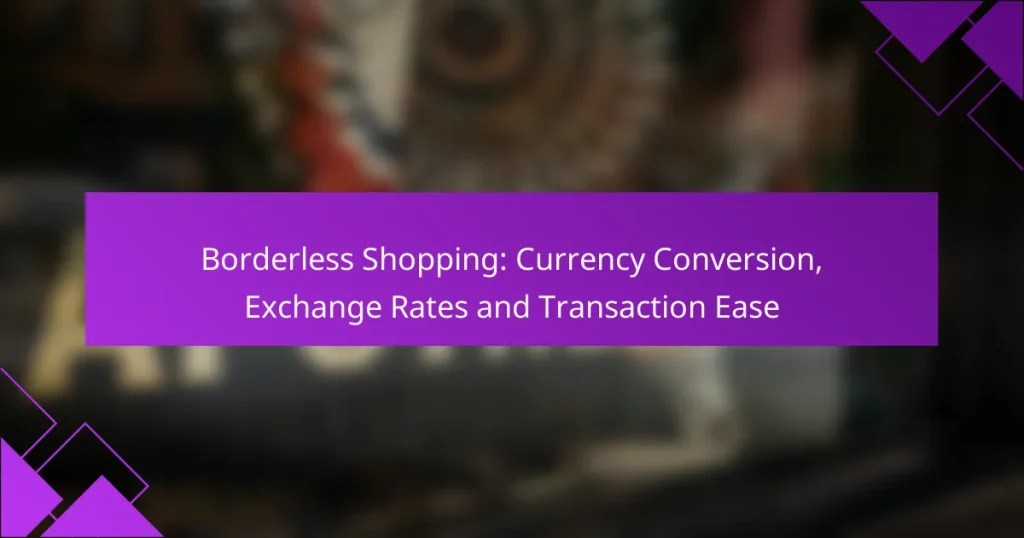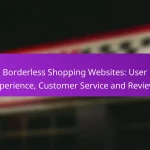Borderless shopping allows consumers to purchase goods from around the world, but it requires a good understanding of currency conversion and exchange rates. By staying informed about fluctuating rates and potential transaction fees, shoppers can ensure a more cost-effective and enjoyable experience when buying internationally. Mastering these elements is key to navigating the complexities of global commerce.

How to shop borderlessly with currency conversion?
Shopping borderlessly involves using currency conversion to make purchases in different currencies easily. By understanding how to manage currency exchange and payment methods, you can enjoy a seamless shopping experience across international borders.
Use multi-currency wallets
Multi-currency wallets allow you to hold and manage multiple currencies in one place, simplifying borderless shopping. These wallets often provide real-time exchange rates and enable you to convert currencies at competitive rates, reducing the hassle of traditional banking methods.
When choosing a multi-currency wallet, look for features such as low conversion fees, support for various currencies, and user-friendly interfaces. Popular options include Revolut and Wise, which cater to a wide range of currencies and offer easy access to funds.
Leverage online payment platforms
Online payment platforms like PayPal, Stripe, and Square facilitate borderless transactions by allowing you to pay in different currencies without needing to convert funds manually. These platforms often handle currency conversion automatically, providing transparency in fees and exchange rates.
When using these services, check for any additional fees associated with currency conversion and ensure that the platform supports the currencies you plan to use. This can help you avoid unexpected costs during your transactions.
Utilize credit cards with no foreign transaction fees
Credit cards that do not charge foreign transaction fees are ideal for borderless shopping, as they allow you to make purchases in different currencies without incurring extra costs. Many travel-focused credit cards offer this benefit, making them a smart choice for frequent international shoppers.
Before applying for a credit card, review the terms and conditions to confirm the absence of foreign transaction fees and consider any annual fees or rewards programs. Cards from issuers like Chase or Capital One often provide favorable terms for international use.

What are the current exchange rates for major currencies?
The current exchange rates for major currencies fluctuate regularly based on market conditions. To make informed decisions while shopping internationally, it’s essential to check these rates frequently, as they can impact the overall cost of your purchases.
Check rates on XE.com
XE.com is a popular platform for checking exchange rates. It provides up-to-date information on various currencies, including USD, EUR, and GBP. Users can easily compare rates and see historical trends, which can help in understanding how rates have changed over time.
To use XE.com, simply enter the currencies you wish to convert, and the site will display the current rate along with any applicable fees. This can be particularly useful for budgeting your international purchases.
Use OANDA for real-time updates
OANDA offers real-time exchange rate information and is widely used by traders and businesses. It provides not only current rates but also tools for analyzing currency trends. This can be beneficial for those who need to make quick decisions based on market movements.
To access OANDA’s services, you can visit their website or use their mobile app. They also offer a currency converter tool that allows you to see the impact of exchange rates on your transactions instantly. This ensures that you are always aware of the best rates available before making a purchase.

How do transaction fees impact borderless shopping?
Transaction fees significantly affect the overall cost of borderless shopping by adding extra charges to currency conversions and payments. These fees can vary widely depending on the payment method and financial institution, impacting the final price of goods purchased from international sellers.
Understand bank fees for currency conversion
When shopping across borders, banks typically charge a currency conversion fee that can range from 1% to 3% of the transaction amount. This fee is applied when converting your home currency into the seller’s currency, which can add up, especially for larger purchases.
Additionally, banks may impose a flat fee for international transactions, which can vary significantly. It’s essential to check with your bank for specific rates and fees associated with foreign currency transactions to avoid unexpected costs.
Compare fees across payment platforms
Different payment platforms, such as PayPal, Stripe, or credit card companies, have varying fee structures for international transactions. For example, PayPal might charge around 4% for currency conversion, while credit cards may offer more competitive rates but still include foreign transaction fees.
To minimize costs, compare the total fees of different platforms before making a purchase. Look for options that offer lower conversion fees or no foreign transaction fees, and consider using services that specialize in borderless payments for better rates.

What are the best practices for currency conversion?
To effectively manage currency conversion, consider converting your currency before making purchases and monitoring exchange rate trends. These practices can help you save money and avoid unexpected costs during international transactions.
Convert currency before making purchases
Converting currency before making purchases allows you to lock in a favorable exchange rate and avoid additional fees from your bank or credit card provider. Use reliable online currency converters or financial apps to check current rates and make conversions.
When converting, compare rates from different sources, such as banks, currency exchange services, and online platforms. Some services may charge a commission or offer less favorable rates, so it’s wise to shop around.
Monitor exchange rate trends
Keeping an eye on exchange rate trends can help you identify the best times to convert your currency. Rates fluctuate due to various factors, including economic conditions and geopolitical events, so staying informed can lead to significant savings.
Consider setting up alerts through financial apps that notify you when rates reach your desired level. This proactive approach enables you to make conversions at optimal times, maximizing your purchasing power in foreign currencies.

How to choose the right payment method for international shopping?
Choosing the right payment method for international shopping involves assessing security, convenience, and transaction speed. Consider options that offer favorable exchange rates and low fees to enhance your shopping experience.
Evaluate security features of payment options
Security is paramount when selecting a payment method for international purchases. Look for options that provide encryption, fraud protection, and buyer guarantees. Credit cards and reputable payment platforms often have robust security measures in place.
Additionally, check if the payment method offers two-factor authentication or alerts for suspicious activities. These features can significantly reduce the risk of unauthorized transactions while shopping online.
Consider convenience and speed of transactions
Convenience and speed are crucial factors in choosing a payment method for cross-border shopping. Digital wallets like PayPal or Apple Pay allow for quick checkouts, often completing transactions in seconds. In contrast, bank transfers may take several days to process.
When evaluating options, consider the ease of use on various platforms and whether the payment method supports multiple currencies. This can save time and reduce the hassle of currency conversion during the checkout process.

What are the prerequisites for effective borderless shopping?
Effective borderless shopping requires a few essential prerequisites, including a stable internet connection and knowledge of international retailers. Understanding currency conversion and exchange rates can also enhance your shopping experience and help you avoid unexpected costs.
Set up a reliable internet connection
A reliable internet connection is crucial for seamless borderless shopping. It ensures that you can browse international websites without interruptions and complete transactions smoothly. Aim for a broadband connection with speeds of at least 25 Mbps for optimal performance.
Consider using a virtual private network (VPN) if you encounter geo-restrictions or want to enhance your online security. This can also help you access localized deals or promotions available only in certain regions.
Research international retailers
Researching international retailers is vital for successful borderless shopping. Look for reputable online stores that ship to your location and offer competitive prices. Check customer reviews and ratings to gauge the reliability of the retailer.
Additionally, familiarize yourself with the retailer’s return policy, shipping costs, and estimated delivery times. Some retailers may offer free shipping over a certain purchase amount, which can save you money. Always compare prices across different platforms to ensure you are getting the best deal available.

